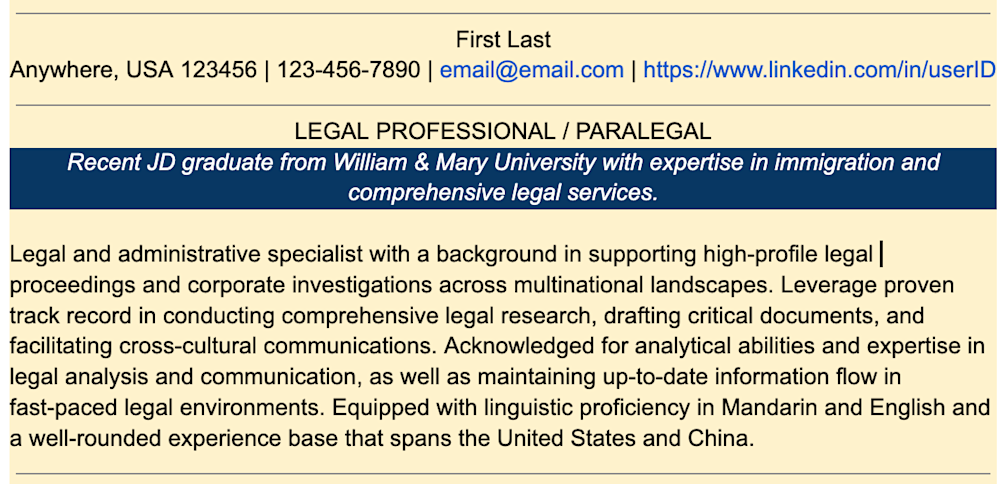How to Include Language Skills on Your Resume

The marketplace has changed dramatically in recent decades, as increased mobility and globalization have made rapid daily trade across continents more widespread than at any point in history. Along with that increased globalization has come a need for language proficiencies that go beyond a worker’s native tongue.
In fact, many companies are consistently seeking employees who are proficient in more than one language – and educational facilities are increasingly focused on teaching those skills to their students. Of course, being proficient in a second or third language is one thing. Properly conveying that information to prospective employers is another thing entirely. So, should you list languages on your resume? The answer is a resounding “Yes!” But how should you list languages on your resume?
There are actually quite a few ways you can include language skills on your resume, including in the Core Competencies and Additional Qualifications sections. In this article, we’ll show you how to list language proficiencies with some examples so you can see what it looks like.
Listing languages on a resume
There are different schools of thought among resume specialists. Some argue in favor of creating a separate resume header section for languages. Others argue that this information should simply be highlighted within the qualifications or skills section of a resume.
There are valid reasons for both choices, and either will work to ensure that the hiring manager understands your language proficiency – if, of course, you accurately document your skill level. The following are some tips to help you know when you should list secondary language proficiencies on your resume.
In alignment with the job description: Does the job listing indicate a preference for candidates with multilingual capability? If so, then you should certainly include specific details about your level of familiarity with the needed language.
Specific language for a role: Does the job listing require a specific language? If you are proficient in that language, be sure to mention that fact in your resume.
You don’t have to be an expert: What if you learned the language but haven’t used it in years? You can still claim some level of proficiency, but may also want to note that you will need to refresh your familiarity with the language to ensure that you’re up to speed.
Stand out from the crowd: What if no language requirement is listed in the job listing? Should you still include your language proficiency? Absolutely! Employers who are faced with a choice between two otherwise equally talented and qualified candidates are likely to view knowledge of a foreign language as a deciding factor – especially when that language is one that is in common use by some segment of their customer base.
Be honest: What if you don’t know the required language at all? This question is a tough one because there may sometimes be a temptation to claim proficiency just to get the job. Don’t do it. If you don’t know that language, just acknowledge that you’re not qualified for the position and move on to another job option.
How should you assess your language proficiencies?
Once you’ve decided that your proficiency merits mention, the next thing to consider is how you should define it. Language is a tricky thing to describe since proficiency can come in many forms – and those who learn second languages often only have true proficiency in certain areas of the language. As a rule, there are four basic elements of language proficiency:
Reading - This describes your ability to understand the language as written.
Writing - This level of proficiency means that you can write comfortably using your secondary language.
Speaking - Can you speak the language without much effort? Then, you can claim this level of proficiency.
Listening - This simply refers to your ability to understand what is being said when others use the language.
As you might imagine, not everyone possesses equal measures of proficiency in every one of these four areas. Some can speak and understand the language with ease but struggle to read or write in the tongue. Likewise, you may be able to understand the language when someone else speaks it but have trouble speaking it yourself. And so on. Determine your strengths and weaknesses so that you can accurately define your proficiency for the employer.
How to list languages on your resume
When deciding where to include languages, you’d probably like to see some examples and practical tips. While there are countless ways to include language on your resume, there are five main options.
1. In the summary paragraph
A great option is to include your language proficiencies as a sentence within the summary paragraph. It would generally appear as the last sentence of the paragraph because you don’t want the skill to get lost within the rest of the text. Here’s an example:

2. Core competencies
You can also include it under your skills section (e.g., “Core Competencies”). This is probably the best option when there is no specific requirement for language proficiency included in the job listing.
Here’s what that would look like:

Expert Tip
EXPERT TIP: View 200+ more professional resume samples for all industries, along with a guide to writing resumes from our career experts.
3. Within your experience section
Some employers want to know that you are capable of working on a global scale, taking into consideration different languages and things like cultural sensitivity. When you are bilingual or multilingual, the chances that you’ll be better able to navigate foreign conversations increases. That means that you’ll be able to converse with customers and vendors, but also shows that you will potentially be able to expand into new markets.
Here’s a way to showcase this:
ABC GLOBAL MARKET INC | Location
Successfully expanded into Latin American markets, leveraging fluent Spanish language skills, resulting in a 30% increase in revenue within one year.
Led cross-cultural negotiation teams, bridging communication gaps and securing key partnerships with European clients.
When including language skills within the experience section of your resume, try to attribute the language proficiency to career achievements, as shown here. Employers want to know what you will bring to the table for their company and team. If you can show something like bringing in 30% more revenue through your language skills, you’ll be able to demonstrate the impact your language skills had.
4. In education and credentials section
Often, if you’ve taken the time to learn new language skills, the accomplishment comes with some sort of certification like a Test of English as a Foreign Language (TOEFL), Diploma in French Language Studies (DEFL), or Japanese-Language Proficiency Test (JLPT). If you have these, or any others, then you can list them in your Education section since it would qualify as something you’ve learned.
Language Proficiency
English: TOEFL iBT Score: 112/120 (Test of English as a Foreign Language)
Date of Test: May 2022
Certification Description: Achieved an advanced level of English proficiency, demonstrating strong reading, writing, speaking, and listening skills.
French: DELF B2 (Diplôme d'Études en Langue Française)
Date of Test: June 2021
Certification Description: Attained an intermediate level of French language proficiency, demonstrating the ability to communicate effectively in everyday situations.
Japanese: JLPT N3 (Japanese Language Proficiency Test)
Date of Test: December 2020
Certification Description: Proven competence in Japanese language skills, including reading, writing, and comprehension at an intermediate level.
By including this level of detail within your Education section, prospective employers have a clear picture of your language proficiency skills and can effectively judge how valuable you’d be to their team.
5. Beneath education
The second option is to list it under "Other Information" or “Additional Credentials." You can also list it under your education.
Additional Credentials
Technical Skills Microsoft Office - Word, Excel, PowerPoint, Outlook; Windows, Mac OS X
Languages Bilingual - Japanese and English
This is often the best choice when you know that language proficiency is something that the company is specifically seeking from its candidates.
Language proficiency scale
There are several ways that you can provide language information. Some people like to simply list the language and the number of years that they’ve studied the tongue. Others try to grade their proficiency.
Using the Common European Framework of Reference for Languages (CEFR) is perhaps the best option to define your own proficiency in terms that indicate its usefulness. The CEFR defines proficiency in groups: basic, independent, and proficient. When you see the phrase “active command of the English language” in a job description, the employer is seeking a B2 level of language proficiency.
Here is how the levels break down, according to CEFR:
A1-A2 is used to define someone who has a basic understanding of a particular language
B1-B2 means that you are an independent user of the second language and can carry on a conversation with ease
C1-C2 indicates the highest level of proficiency in a language
Get creative
You don’t have to use the CEFR scales to define the level of achievement you’ve acquired in other languages. It’s okay to be creative when listing your language. The main goal is to list your skills in a way that clearly shows your proficiency level and helps you stand out from the sea of sameness.
Here are some ideas for you to use as inspiration:
Language Skills
Independent use of both English and Spanish, conversant in French, Chinese
Six years of high school and college Spanish education
Interned in Paris, France for two years after graduation
Certificate in conversational Chinese, Superior University, 2014
It's also important to describe yourself as bilingual to ensure that the hiring manager doesn’t assume that your secondary language is the only one that you speak (yes, this can happen!). Just something to keep in mind so that you avoid any unnecessary confusion.
Simple but effective
Including your language skills on your resume is a simple but effective way to impress hiring managers. So long as you remember the golden rule of properly assessing your skill level and accurately portraying the skills, whether the job calls for bilingualism or not. At the end of the day, that information may just be the determining factor that helps you to get the job of your dreams!
Are your language proficiencies listed properly on your resume? ZipJob’s team of professional resume writers can work with you to assess your job market and the relevance of your language skills to properly showcase them to hiring managers.

